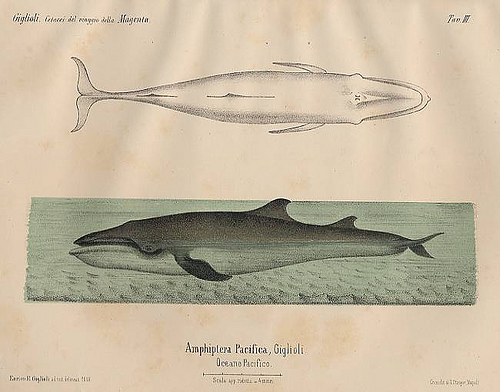Thursday, January 16, 2014
Giglioli's Whale
The baleen whales are Earth's largest living vertebrates. The greatest among them weigh 200 tons, and some exceed a hundred feet in length. This makes it all the more shocking that whales are so mysterious. Their breeding grounds and migration routes are still under study, and much about their lives remains unknown. In fact, despite their size and our technological prowess, some whale species have eluded detection for centuries. New whales have been discovered even in the last decade-- and more may remain undiscovered.
Among these, according to some cryptozoologists, is Giglioli's Whale. It was first described-- and scientifically named-- by the zoologist Enrico Giglioli. He observed it at length in 1867, while it swam off the Chilean coast. The animal measured sixty feet long, and resembled a right whale. But it had one unique feature-- a second dorsal fin-- that distinguished it from all other cetaceans.
Giglioli never saw the whale again, but hoped that other scientists would have better luck. Few did-- since then, the species has only been sighted twice. One sighting, off the coast of Scotland, was documented in 1868. The other occured in the 1980s, near the island of Corsica. No specimen of the whale has ever been collected, and most scientists doubt its existance.
Still, some classify it as a proper marine species-- though a rare one, and infrequently encountered. Scientists encountered several megamouth sharks before the first was captured, and some proven whale species have yet to be caught alive. Will Giglioli's Whale be a similar success story? Only time will tell.
Read more about Giglioli's Whale:
http://biologicalmarginalia.wordpress.com/2013/01/01/amphiptera/#more-8
http://seamonsters.wikispaces.com/Giglioli's+Whale
Image from http://www.futilitycloset.com/wp-content/uploads/2008/03/2008-03-31-gigliolis-whale.jpg (public domain)
Subscribe to:
Post Comments (Atom)

No comments:
Post a Comment